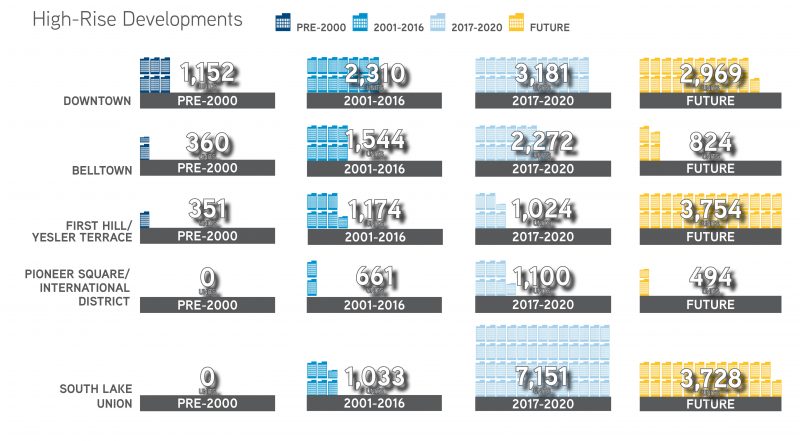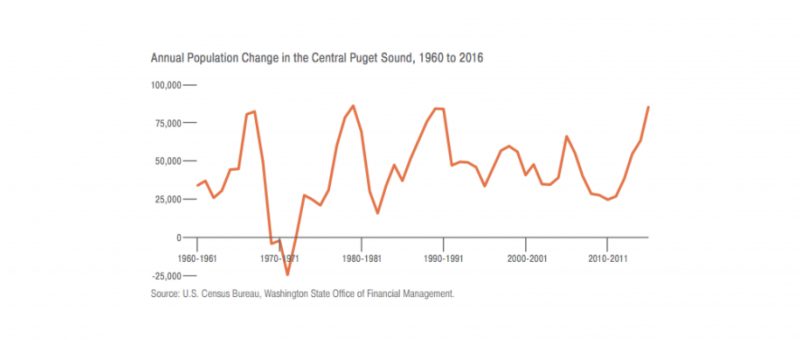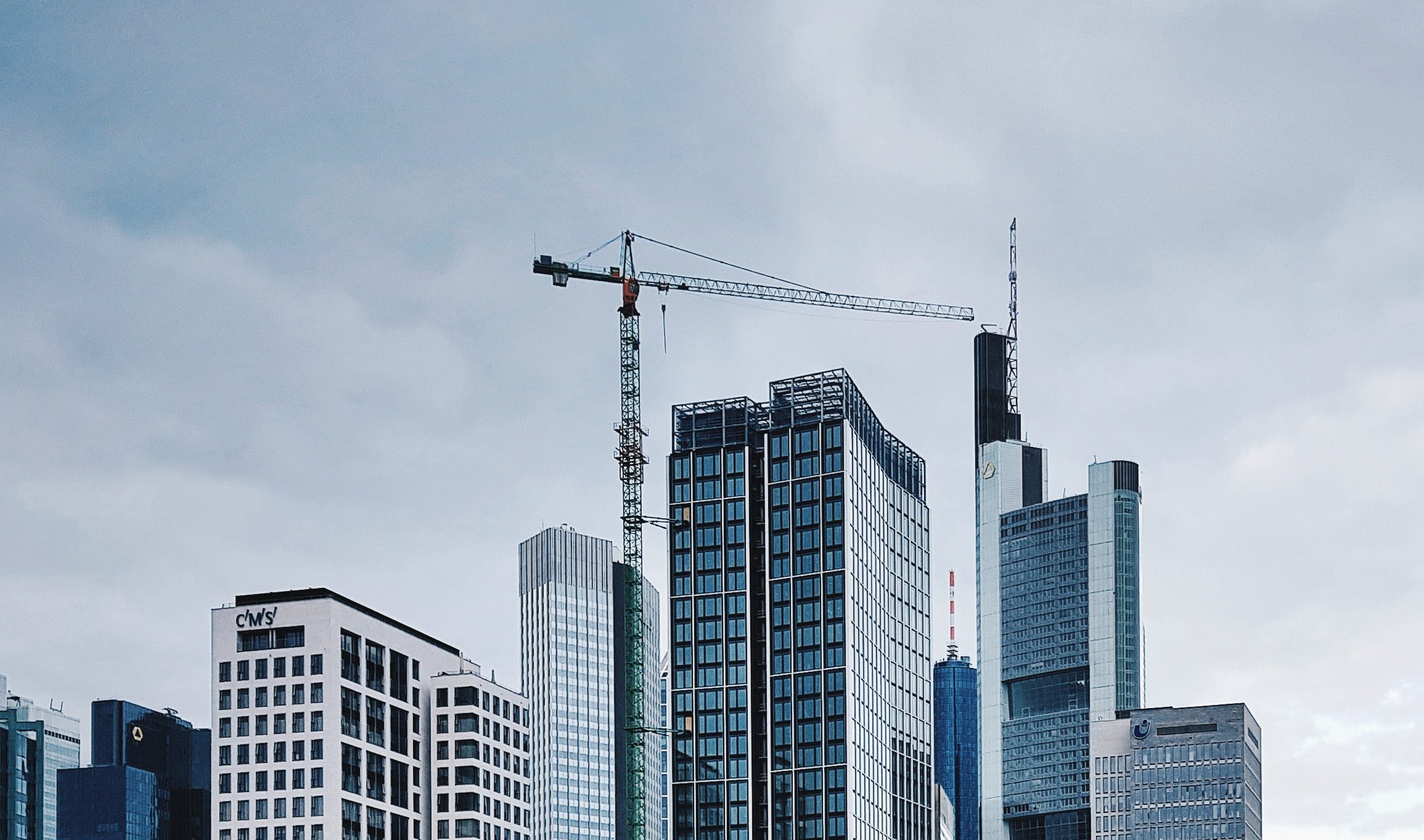Seattle is a city of great urban neighborhoods. Seattleites remain extremely proud of the fabric of their particularly unique, yet parochial neighborhoods. Spend enough time in Seattle and you will hear “Phinney Ridge has the BEST Italian food”, as if fork-twirling pasta dare not exist in another neighborhood in our fair city. As they say, everyone lives in the BEST neighborhood in Seattle!
As the city grows (and grows and grows), new residents are landing in neighborhoods across the city, trying out different locations until they land in their adopted neighborhood of choice. However, much apartment development is occurring in five key “zones,” some of which were not considered neighborhoods just 15 years ago.
Why do these “zones” matter, one may ask? The answer lies in the question – zoning!
Seattle’s skyline is quickly filling with residential high-rise buildings: plans for 43 new high-rises and more than 14,000 units are in development in the next 3 years! More than 7,500 high-rise apartment units are planned for 2017 alone.
Yet the influx of high-rise development of +35,000 units in heretofore “non-neighborhoods” leads to the preeminent question:
Is Seattle becoming a high-rise town?

The Seattle apartment development pipeline suggests one direct answer – YES!
Current zoning allows high-rise apartments in only five zones within Seattle. Yet vertical living in these submarkets is a recent and growing phenomenon.
A study of 20 years across these zones provides a quick snapshot of growth versus inventory:
- Pre-2000: There were 4 residential high-rises with a total of 1,863 apartment units
- 2001-2016: Another 23 high-rises join the skyline with 6,722 additional apartment units
- 2017-2020: An incredible 43 high-rises are planned, with more than 14,000 units
- Future: 28 high-rises are planned, equating to more than 11,700 units
Considering the city’s remarkable job growth over the past few years, there is no question as to demand for new housing units. An average of 236 people move to Seattle every day, helping Seattle achieve the ranking of the 4th fastest growing city in the U.S. last year.

But what about that quaint French restaurant in Wallingford, or the perfect park to walk your dog on a Saturday morning on Queen Anne Hill? Walk through the heart of South Lake Union on a Saturday morning and you may have the streets to yourself.
Residents, both established and newcomers, clamor to find housing that best fits their needs – both functional (e.g., proximity to work, price-point) and emotional (e.g., character/identity, close to friends).
How will the spate of new high-rise development fit the needs of our city?
An analysis of the high-rise development pipeline in each of the city’s high-rise zones reveals how development and demand are shaping the city’s future and the potential establishment of newly formed urban neighborhoods.
Downtown Seattle

Downtown’s high-rise development increased by 50% in the last 16 years, and it’s poised to increase by another 27% in the next 3 years. Expect a lot more crowding in the city’s skyline in the 10 years. Are there residents to fill these glassy towers?
The Downtown Seattle Association’s data suggests a downtown population of greater than 70,000, boasting an 18% increase in the last 6 years. Restaurants and retail continue to follow. Back to the Saturday morning question: will the 6,000 new units coming to downtown Seattle shape our CBD into a neighborhood?
Belltown

Belltown continues to add inventory in the near future with 8 new high-rises planned for development between 2017 and 2020. Opposite of Downtown, Belltown was a true “neighborhood” before it became a magnet for zoning-based high-rise development. In the early 2000s, Belltown was akin to San Francisco’s Marina/Cow Hollow – aka “Campus” for post-college early 20-somethings.
Unfortunately, the club scene and attendant arrival of the B & T crowd (“Bridge & Tunnel” for the non-New Yorkers) drove out residents and retail/restaurants alike. The rise in new residential towers, proximity to Amazon, and availability of retail space sets the stage for Belltown’s resurgence as a true urban neighborhood.
First Hill / Yesler Terrace

First Hill and Yesler Terrace remain the picture of steady growth, adding inventory in each time period without periods of saturated construction. And on the horizon is a mounting pipeline of new development.
“Pill Hill,” as it is oft-referred, was less of a neighborhood and more of a collection of hospitals, hospital services, and housing for the elderly and infirm. Although many residential uses exist on First Hill, the fabric of a neighborhood was not yet laid. However, change is on the horizon.
The definition of a new Yesler Terrace is all but guaranteed. New market-rate housing lines Broadway and the 12th Ave Corridor (aka – Capitol Hill South), and a new First Hill Streetcar with its Broadway Extension guarantees interconnectedness all the way from Pioneer Square to the Capitol Hill light rail Station.
Pioneer Square / International District

Rising from no high-rise inventory pre-2010, Pioneer Square earned a place on the map with the magnificent arrival of The Post, NoLo and Wave between 2014 – 2015. It’s hard to argue that Pioneer Square is not a neighborhood – especially as it is clearly understood as Seattle’s “First Neighborhood.”
Like they say in Field of Dreams, Pioneer Square’s rise is a story of “build it and they will come” – and they did, and did so paying $3.50+ square foot rents!
Pioneer Square and the International District are secretly Seattle’s best neighborhoods, and the continued growth of the Stadium District will only increase the desirability of these urban neighborhoods. In the recent past a lack of development was more based on investor sentiment than anything. Today, its desirability as an investment market is a foregone conclusion.
South Lake Union

South Lake Union continues to be Seattle’s fastest growing neighborhood. Tech companies rush to claim real estate for their headquarters while developers build up, up and up to meet demand for the tech and life sciences employees who desire a short walk to work.
South Lake Union is truly a “chicken versus egg” study. Many great urban neighborhoods found their roots borne out of neighborhood character and patina – retail and restaurants emerge, new residents follow. Ballard, West Seattle and Columbia City were all recently reshaped by this pattern of growth.
With nearly 11,000 residential units planned in this one zone of the city, its growth and the attendant character of its growth will remain fascinating to watch.

